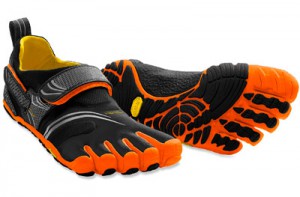
Gear Advice: Footwear for Pohnpei
Zories / Flip-Flops
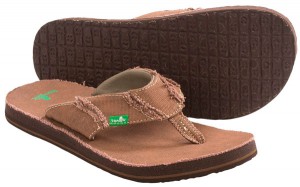
PROS: They’re ultra-easy to take on and off. Your feet are completely exposed to the air and dry quickly.
CONS: When wet or muddy, your feet slide around from side to side and from front to back. Straps are often too weak to handle rough treatment and frequently break. Zories get sucked right off your feet in swift-moving water, mucky sand, or oozy mud. They have absolutely no traction capabilities. Your feet are completely unprotected.
THE VERDICT: Flip-flops are great when cruising around town or hanging on the boat or beach, and that’s about it.
Tennis Shoes
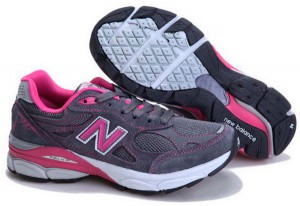
PROS: They’re light. They breathe better and tend to have more flexible soles than heavier footwear, allowing your feet marginally better traction. The toes, tops, and sides of your feet are better protected from scrapes and bangs than with sandals or FiveFingers.
CONS: Tennis shoes have no ankle support. They inevitably get soaked in Pohnpei’s wet environment, and once wet, your feet stay wet. Furthermore, the shoes aren’t going to dry out between hikes in the humidity — even on sunny days. Though soles are thinner and more flexible than hiking boots or Teva-style sport sandals, the type of sole material and tread varies from shoe to shoe. By and large, tennis shoes don’t have tread that performs well on wet rocks or muddy slopes — the most common type of terrain Pohnpei hikers encounter. Shoes are easily pulled right off your feet in deep mud.
THE VERDICT: Tennis shoes are fine for short, easy hikes on roads or well-established gravely trails.
Cloth Hiking Boots
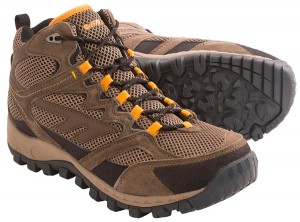
PROS: They’re only slightly heavier than tennis shoes. Soles and tread tend to be better designed for hiking in rough terrain than tennis shoes or sandals. They provide good ankle support. Your feet and ankles are protected from scrapes and bangs.
CONS: Breath-ability is poor. Your feet get wet and stay wet. The thickness of the soles makes it harder for them to adhere to wet, curved surfaces, such as river rocks. The deeper tread is mostly ineffective in muddy conditions as the grooves simply fill with mud. Just like tennis shoes, in deep mud, they can be pulled right off your feet.
THE VERDICT: Cloth hiking boots aren’t particularly useful on an ultra-wet tropical island. It’s best to leave them at home.
Hard-Shell Hiking Boots
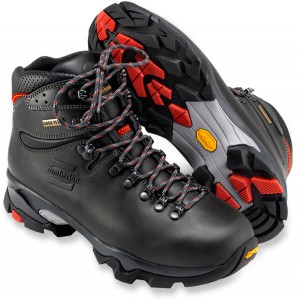
PROS: They provide maximum ankle support and foot and ankle protection.
CONS: They’re unnecessarily heavy and wear you out faster than lighter shoes. The soles are thick and inflexible — highly undesirable when crossing slick rocks in rivers or scrambling up muddy mountainsides. They aren’t breathable at all; even if they’re fully waterproofed, your feet will end up soaked by sweat anyway. They’re absolutely impossible to deal with in deep, oozy mud.
THE VERDICT: Hard-shell boots are a very poor choice for this environment.
Teva-Style Sport Sandals
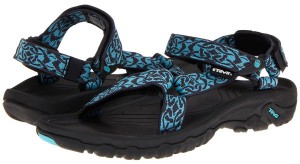
PROS: The open-air style allows your feet the greatest opportunity to dry out. There are less places for sand and grit to get stuck.
CONS: Your toes, heels, and the sides of your feet are completely unprotected and can be battered by rocks and roots. When wet, feet tend to slide around on the sole. Blisters around the straps are problematic on anything but short hikes. The Velcro fasteners get caught on vines and other things and pulled open. The thick, inflexible soles are nearly as bad as hard-shell boots when it comes to traction. For footwear designed with rivers in mind, they’re remarkably poor at adhering to wet rocks slimed with algae. They tend to become mired in deep mud like what you find in mangrove swamps.
THE VERDICT: Sport sandals work well when paddling, walking around town, or doing short, relatively-flat hikes on roads or well-established trails.
FiveFingers
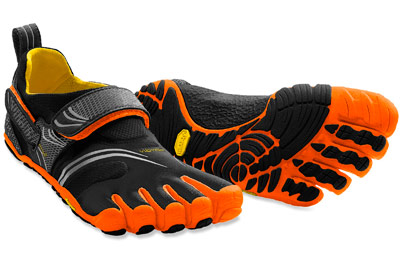
PROS: The revolutionary design concept centers around research that has shown that balance and traction are significantly improved by having the use of your toes and letting your feet flex and mold themselves to whatever surface they move across. Thin, soft soles allow maximum flexibility and adhere well to wet rocks and other surfaces. “Free” toes can dig into mud for better traction, and because they fit like a second skin, they won’t come off your feet. They’re ultra-light. Thin material or mesh allow your feet plenty of access to air.
CONS: There’s no ankle support and minimal protection from the environment; toes, feet, and ankles can take a brutal beating from rocks and roots. You can’t just jump right into things; you have to break in FiveFingers, take some time to allow your feet to get used to full contact with the terrain, and learn to walk with greater care and precision. They are designed to fit like a glove, and consequently, are very difficult to put on. In sandy conditions, grit gets inside the heels and rubs the skin raw.
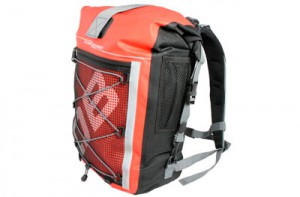
Dry-Bags
For ages backpackers and other outdoor adventurers have struggled to keep the contents of their backpacks dry when out in the elements. In some environments, where rain is a rarity, simply having a waterproof nylon bag-cover was enough. But in places where wet was the norm, bag-covers just didn’t cut it. For one thing, no bag-cover could ever seamlessly envelope the entire backpack; the area where the straps are was always uncovered, allowing rain to drip down the hiker’s back and eventually soak into the bag. Furthermore, the nylon covers were thin and relatively fragile. When pushing through trees or brush, they’d snag and tear. Some people resorted to lining the inside of their backpacks with garbage bags, which kept their stuff dry, but allowed the exterior of the bag to be soaked.
Eventually someone — probably a paddler — decided that what they needed was an air-tight / water-tight bag so secure it would even float if dropped into water. Enter the roll-top dry-bag.
Basic PVC Roll-Top Dry-Bags
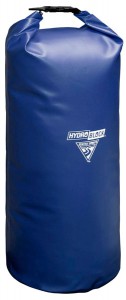
Roll-top dry-bags work in the following way. There’s one opening at the top. Users fold the excess material at the opening over itself repeatedly and then use a set of plastic buckles to tightly secure it, trapping a small amount of air within the bag. Once clipped, the bag is fully-waterproofed and — presuming it has enough air trapped inside and isn’t too heavy — will float. The most common bags are made of PVC and consist of seamless cylinder with a bottom welded on, and in some models, also taped or glued.
PROS: Unless there’s some sort of manufacturing defect, these bags really do keep their contents dry, even when completely submerged, and that’s really the whole point. The heavy, durable PVC is rip and tear-proof and stands up to rough treatment just fine (I have one that I’ve been using for 19 years). The bags are excellent for use in boats, kayaks, canoes, etc. See-through styles are available, which allow you to figure out where something you need is before you dig around in the bag.
CONS: It is possible to puncture PVC bags with sharp objects. They’re heavy when compared to nylon and other typical bag materials. Because the PVC is quite thick, they don’t compress well when empty and take up a lot of space. The roll-top style makes them pretty inconvenient if you’re going to be removing and re-stowing things in your bag regularly (such as a camera). Kayakers will be forced to stop paddling completely and use both hands to open and close the bag properly — which may be impossible if there’s rough water or strong current. The bag interiors have no built-in padding, so something like a camera or lens has to be wrapped or otherwise cushioned in some way. Bags have no interior divisions or pockets, so finding one object is difficult without dumping everything out.
THE VERDICT: PVC dry-bags suffer from the same inconveniences as all roll-top bags, but they still perform very well when it comes to doing what they are designed to do — keeping your stuff dry. Good brands include Overboard, Seattle Sports, Cascade Designs SealLine, and Sea to Summit.
Basic Nylon Roll-Top Dry-Bags
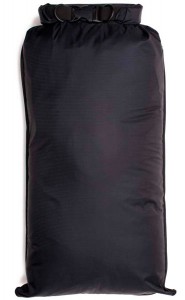
Non-permeable nylon bags with the same design as the PVC bags are also available.
PROS: They’re super light and compress to almost nothing when empty.
CONS: The thin nylon is not very durable; it can snag and rip or tear and is far more prone to punctures than PVC. Seams are generally taped and glued, which theoretically should make them leak-proof, but sometimes they fail anyway. The nylon provides even less protection than the PVC for the contents of your bag. They have all the same inconveniences as any other roll-top bag: they take care to close up properly and have no inside divisions or pockets.
THE VERDICT: Nylon dry-bags really work best packed inside a conventional backpack or mesh dive bag. Using multiple nylon bags inside a backpack is one way to keep your stuff organized and dry at the same time. They’re too fragile to perform well on their own, however. Good brands include Overboard, Seattle Sports, Cascade Designs SealLine, and Sea to Summit.
Roll-Top Dry-Packs
The dry-backpack developed from the simpler dry-bag concept — a heavy PVC sack with a single roll-top opening. The pack style incorporates back padding, padded shoulder straps, chest and waist straps, and (depending on the model) an outer pocket or mesh. There aren’t many brands that make dry-packs and two stand out — Overboard and Seattle Sports.
Seattle Sports Aquaknot Dry-Pack
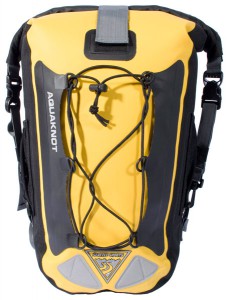
PROS: The Aquaknot performed well on both trekking and paddling excursions on Pohnpei. It never leaked. Though not as heavily padded as the Overboard bags, the pack is comfortable enough on the body. The model comes in two capacities — 22 and 29 liters. It has one mesh side-pocket on the outside for a small bottle or other object. There are two clipping options. The chest strap and waist belt help distribute weight across the body.
CONS: The bungee area is useless; it would have been better with a rear pocket instead. There are no interior pockets or other divisions. Access is only through the roll-top.
THE VERDICT: This is a good, solid, dependable bag. Though slightly smaller than the Overboard models, it measures up.
Overboard Dry Backpack
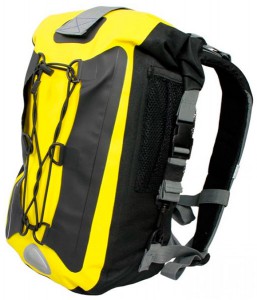
PROS: When tested on Pohnpei, the bag stood up to abuse and never leaked. The padded shoulder straps, back, and lumbar support make this bag pretty comfortable to wear, even when it’s heavy. The chest and waist straps help keep the weight positioned properly on your body. With three different capacities going up to 30 liters, there should be plenty of room for gear. The single interior pocket is great for small stuff you need to find quickly like a flashlight, keys, or box of matches. There are two options for clipping the top closed and a nice top handle for picking up the bag. There’s an elasticized mesh pocket on the side, which can handle small bottles or other objects.
CONS: There are no interior divisions and no interior padding to protect gear. Contents can only be accessed through the roll-top. The bag is heavier than a conventional backpack. The bungees on the back are mostly useless; they stretch out over time and get snagged on stuff. The Velcro strap on the top doesn’t really do anything except get snagged on low branches and brush.
THE VERDICT: Though it lacks a few useful features, this pack performs well and has a good design.
Overboard ProSport Dry Backpack
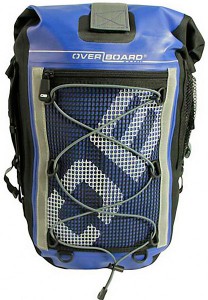
PROS: Like the other packs we’ve reviewed, this model has good padding on the shoulder straps and back, a comparable chest strap and waist belt, and a top carry handle. It also has a zippered interior pocket. The capacity is 30 liters — plenty big enough for all the gear you need on a short trek. It never leaked when we tested it in a wide range of conditions on Pohnpei. One thing it has that the other bags don’t have is a useful zippered mesh pocket on the back. And for some reason, it’s slightly cheaper than the other Overboard bag above.
CONS: Other than the one pocket, there are no interior divisions. The bag has no padding. It’s heavier than a conventional backpack. The contents can be accessed only through the roll-top. The bungees aren’t really useful for anything.
THE VERDICT: This is a very good dry backpack with a few small advantages over the Overboard Dry Backpack and Seattle Sports Aquaknot.
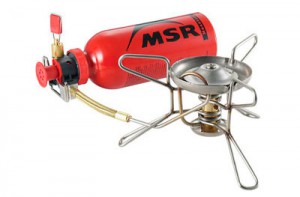
Gear Advice: Backpacking Stoves for Pohnpei
Liquid Fuel Stoves
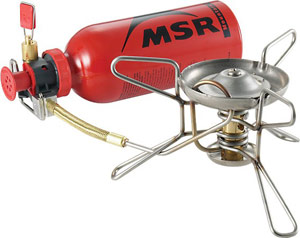 Liquid fuel stoves, such as those made by MSR and Optimus / Svea, are an option on Pohnpei, as white gas is available at the local hardware stores.
Liquid fuel stoves, such as those made by MSR and Optimus / Svea, are an option on Pohnpei, as white gas is available at the local hardware stores.
PROS: They heat quickly and have adjustable flames. They perform well in windy conditions. You can buy the fuel on-island.
CONS: You can’t bring these stoves on the airplane — you’d have to ship them to yourself surface mail, which would take up to 2 months. Liquid fuel stoves are also notorious for clogging. You have to waste fuel to prime some of them. The fuel is pretty toxic, and if it leaks in your pack, it will ruin a lot of stuff. Fuel has to be stored in metal bottles — which are heavy. The stoves themselves are also heavy.
Canister Stoves
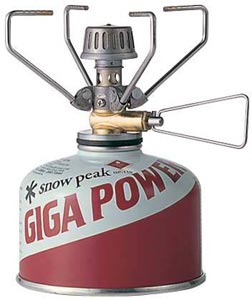 These stoves are fueled by an external butane or propane fuel canister that is thrown away when depleted.
These stoves are fueled by an external butane or propane fuel canister that is thrown away when depleted.
PROS: They are more fuel-efficient than a liquid fuel stove.
CONS: The canisters are expensive and heavy. You can’t find replacement canisters in Pohnpei’s stores. Canisters can’t be brought on an airplane at all (including airmail), because they contain pressurized, flammable material. They’re also very bad for the environment; empty canisters can’t be refilled — they end up as trash.
Alcohol Stoves
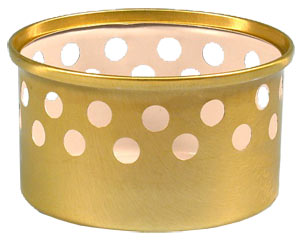 The last choice is the alcohol stove. This is the simplest type of stove, the lightest, and the least prone to malfunction, because it has no complicated parts (no parts at all). It is nothing more than a reservoir that holds fuel, which is set aflame and burns out on its own.
The last choice is the alcohol stove. This is the simplest type of stove, the lightest, and the least prone to malfunction, because it has no complicated parts (no parts at all). It is nothing more than a reservoir that holds fuel, which is set aflame and burns out on its own.
PROS: The benefits of this stove type for an adventure trekker are many. Alcohol stoves are small and weigh less than 28 g (5 oz). They are fueled by denatured alcohol, which is cheap and can be purchased at Pohnpei’s hardware stores. Fuel can be stored in a regular plastic bottle. You can make the stove itself for less than $10.00 with simple materials found on Pohnpei, so you don’t need to worry about bringing one. If you do bring one, it can be taken on the airplane, as long as it’s clean.
CONS: Alcohol stoves have a slower than average boil time (6-8 minutes) and a lack of flame adjustment. It’s easy to crush these tiny stoves, but they can usually be bent back into shape with relative ease.
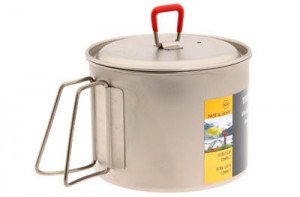
Gear Advice: Backpacking Cookware for Pohnpei
MSR Titan Kettle
 This is a popular model among ultra-light trekkers. It holds 0.85 L (0.9 qt) and has a lid and folding handles.
This is a popular model among ultra-light trekkers. It holds 0.85 L (0.9 qt) and has a lid and folding handles.
PROS: It’s light — just 4.2 oz (119 g) — very durable, and not too pricey (about $60.00).
CONS: After heating, the handles are too hot to pick up bare-handed. This pot has a reputation for being hard to clean (some foods tend to stick). It’s too small if you’re cooking for two.
Evernew Titanium Pasta Pot
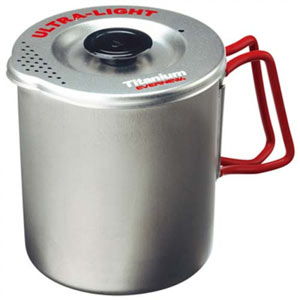 This is a 1 L (1 qt) pot with folding insulated handles and lid.
This is a 1 L (1 qt) pot with folding insulated handles and lid.
PROS: It’s even lighter than the MSR Titan Kettle at 4.1 oz (116 g). The insulation on the handles makes it possible to grip them without protection. It has a nice strainer feature on the lid for pouring off excess water. You can get it for cheaper than the Titan, too, at about $45.00.
CONS: It’s not quite as durable as the MSR Titan. Like the Titan, it’s a small pot that isn’t practical when cooking for others.
MSR Base 2 Pot Set
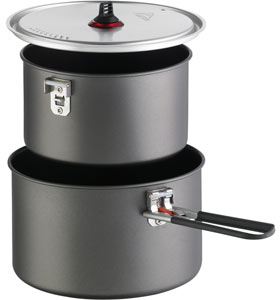 If you’re cooking for two or more, the MSR Base 2 Set is an option. It includes 1.5 L (1.6 qt) and 2.5 L (2.6 qt) pots that nest inside each other, a lid, and a detachable pot-holder.
If you’re cooking for two or more, the MSR Base 2 Set is an option. It includes 1.5 L (1.6 qt) and 2.5 L (2.6 qt) pots that nest inside each other, a lid, and a detachable pot-holder.
PROS: For what’s included, the weight isn’t too bad — about 1 lb (481 g) for everything. The coating on the pots prevents sticking of food, making cleaning easier. The detachable handle doesn’t get hot the way an attached handle does.
CONS: Aluminum isn’t as light as titanium and it’s also less durable — the pots tend to get bent out of shape. They also scratch easily; the coating doesn’t stand-up over the long-term. It’s way too heavy if you’re cooking just for yourself.
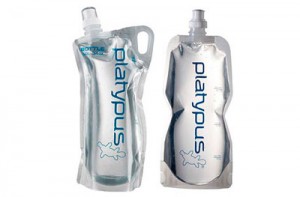
Gear Advice: Water Bottles for Pohnpei
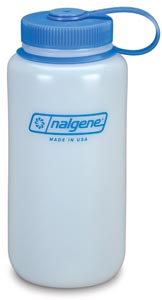
Hard-Sided Bottles
Hard-sided plastic bottles made by companies like Nalgene are a common choice among backpackers.
PROS: They don’t leak in your bag or crack when dropped (at least the stalwart classic model).
CONS: They’re heavy and bulky, and an empty bottle will take up just as much space in your pack as a full one. This is a problem when you’re doing longer hikes, where every bit of your backpack real estate is precious, or when covering very rough terrain, when you want your load as light as possible.
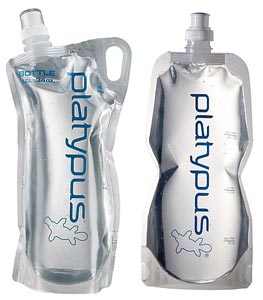
Collapsible Bottles
An alternative to hard bottles are soft-sided bottles, like those sold by Platypus. These are essentially the modern version of the water skin. They have small openings to prevent the water from spewing out when handled.
PROS: They’re light and can compress to next to nothing when empty.
CONS: They can rip or puncture, and they aren’t as easy to refill as hard-sided bottles because of the small mouths.

Hydration Bladders / Reservoirs
A third choice for water storage is a hydration bladder or reservoir. This is essentially a large, plastic water sack with a drinking tube and valve at one end. Bladders usually go with a canvass or nylon pouch or backpack-style carrier. Many good companies make them, including Camelbak, Platypus, MSR, Nalgene, and Osprey.
PROS: There are several really strong points to using bladders. They allow you to distribute the weight of the water you’re carrying evenly across your back, and they are lighter than hard-sided bottles. The bladders are designed to lay flat, and because they are soft-sided, you’ll never have to worry about the corner of a bottle sticking into your ribs or scapula as you hike. You can find backpacks with an outside pocket specifically designed to hold the reservoir. The reservoir doesn’t need to be removed from your pack in order to drink, because the drinking tube is always hanging over your shoulder. In fact, you don’t even need to stop hiking; you can just grab the valve with your mouth and bite down on it to drink as you chug along. Almost all bladders have a large screw-top opening, which makes filling them easier.
CONS: Reservoirs are designed to carry all your water, so they tend to be much bigger than soft-sided bottles, and as you drink the water, what’s left sloshes around a lot until you stop to refill. Marginally annoying. They are also heavier than soft-sided bottles, mainly due to the drinking tube. Like soft-sided bottles, bladders can be punctured or torn and are also prone to leaks at the seams. Filling them completely can be a challenge if you’re dealing with a stream or waterfall; you’ll need someone to hold the bladder up in the air and then either pour or pump water into it (you can’t fill it while the thing is lying on the ground). The bite valves get chewed up over time and don’t work as well anymore. They can also clog easily if there’s any sediment in your water. Perhaps the biggest drawback is keeping bladders clean. They don’t dry easily inside and are prone to bacterial and fungal growth; it is necessary to regularly flush them with vinegar, baking soda, or bleach. Sometimes the water can taste a bit funky compared to other types of water storage — probably due to the previous point. Finally, bladders are the most expensive option for water storage.
For an in-depth review of the top 10 hydration bladder models on the market, check out this article at SealGrinderPT.
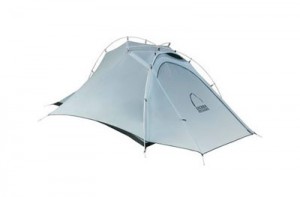
Gear Advice: Shelters
Tents
 Weekend hikers usually think of tents as the definitive backpacking shelter, but they actually have many drawbacks. One tent model is available for purchase on Pohnpei, but it’s so heavy you’d never want to hike anywhere with it much less Pohnpei’s rugged mountains and rainforest. Those set on using a tent should bring one from home. Sierra Designs is a good brand.
Weekend hikers usually think of tents as the definitive backpacking shelter, but they actually have many drawbacks. One tent model is available for purchase on Pohnpei, but it’s so heavy you’d never want to hike anywhere with it much less Pohnpei’s rugged mountains and rainforest. Those set on using a tent should bring one from home. Sierra Designs is a good brand.
PROS: Tents are easy to set up on any patch of relatively flat ground and don’t require trees. They protect sleepers against wind and blowing rain. They keep the bugs out.
CONS: They’re very heavy and bulky. Even the most well-ventilated models don’t provide enough airflow to be comfortable in Pohnpei’s extremely warm, humid climate, soaking the occupants in sweat and the condensation from their breath. They require a groundsheet as insulation, which is added weight in your pack. The typically nylon rainflies won’t be able to stand up to Pohnpei’s torrential rains for very long. The poles sometimes break. Finally, good tents are really expensive — $500+ is not unusual.
Tarp Systems
The “big blue tarp” that is widely sold on Pohnpei is terrible for hiking — bulky, very heavy, and difficult to hang without a lot of conveniently located trees and skeins of heavy rope. There are, however, tarps that are well-designed for trekking. The best are made by Mountain Laurel Designs.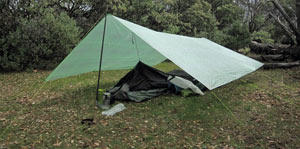
For a single sleeper, the 2.1 x 1.5 x 2.7 meter (7 x 5 x 9 ft) Cuben Fiber Grace is a good choice. It only weighs 180 g (5.9 oz), the ridgeline is bonded and taped, and there are 8 tie-outs. The tarp can be hung as an A-frame with a ridgeline or pitched like a tent with trekking poles as the vertical supports. Cuben Fiber can stand up to a solid night of heavy rain without issue.
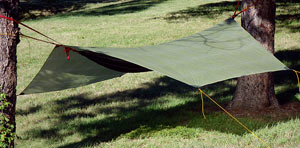 For a pair of sleepers, the Cuben Fiber Grace has a larger 2.6 x 2.1 x 2.8 meter (8.5 x 7 x 9.2 ft) version that weighs 225 g (7.8 oz). Also, a larger, heavier option is the 3.2 x 2.6 meter (10.5 x 8.5 ft) Hammock Hexagon Tarp, which weighs 241 g (8.5 oz). It also has a bonded and taped ridgeline seam, but only 6 tie-outs. Though it is designed to hang above a hammock, it can also be pitched A-frame tent style with trekking poles.
For a pair of sleepers, the Cuben Fiber Grace has a larger 2.6 x 2.1 x 2.8 meter (8.5 x 7 x 9.2 ft) version that weighs 225 g (7.8 oz). Also, a larger, heavier option is the 3.2 x 2.6 meter (10.5 x 8.5 ft) Hammock Hexagon Tarp, which weighs 241 g (8.5 oz). It also has a bonded and taped ridgeline seam, but only 6 tie-outs. Though it is designed to hang above a hammock, it can also be pitched A-frame tent style with trekking poles.
PROS: These tarps are super light and pack small, can handle Pohnpei’s regular torrents, and provide plenty of durability. Unlike tents, they allow plenty of airflow, making sleeping more comfortable.
CONS: They’re super expensive — $285-300. They take some experience to hang properly and can be frustrating if you don’t know what you’re doing. If you’re pitching tent-style, you’ll need trekking poles or something else to use as vertical supports.
How-To Videos
How to Hang a Ridgeline
How to Tie a Cow Hitch Knot
How to Use a Sleeping Hammock

